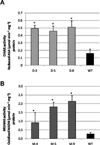Constitutively expressed DHAR and MDHAR influence fruit, but not foliar ascorbate levels in tomato
- PMID: 21875809
- PMCID: PMC3310224
- DOI: 10.1016/j.plaphy.2011.08.003
Constitutively expressed DHAR and MDHAR influence fruit, but not foliar ascorbate levels in tomato
Abstract
Vitamin C (L-ascorbate, AsA) is an essential nutrient required in key metabolic functions in humans and must be obtained from the diet, mainly from fruits and vegetables. Given its importance in human health and plant physiology we sought to examine the role of the ascorbate recycling enzymes monodehydroascorbate reductase (MDHAR) and dehydroascorbate reductase (DHAR) in tomato (Solanum lycopersicum), an economically important fruit crop. Cytosolic-targeted tomato genes Mdhar and Dhar were cloned and over-expressed under a constitutive promoter in tomato var. Micro-Tom. Lines with increased protein levels and enzymatic activity were identified and examined. Mature green and red ripe fruit from DHAR over-expressing lines had a 1.6 fold increase in AsA content in plants grown under relatively low light conditions (150 μmol m(-2) s(-1)). Conversely, MDHAR over-expressers had significantly reduced AsA levels in mature green fruits by 0.7 fold. Neither over-expressing line had altered levels of AsA in foliar tissues. These results underscore a complex regulation of the AsA pool size in tomato.
Copyright © 2011 Elsevier Masson SAS. All rights reserved.
Figures



Similar articles
-
Light-dependent regulation of ascorbate in tomato by a monodehydroascorbate reductase localized in peroxisomes and the cytosol.Plant Biotechnol J. 2013 Apr;11(3):344-54. doi: 10.1111/pbi.12020. Epub 2012 Nov 6. Plant Biotechnol J. 2013. PMID: 23130940
-
Gene expression of monodehydroascorbate reductase and dehydroascorbate reductase during fruit ripening and in response to environmental stresses in acerola (Malpighia glabra).J Plant Physiol. 2011 Apr 15;168(6):619-27. doi: 10.1016/j.jplph.2010.09.003. Epub 2010 Oct 8. J Plant Physiol. 2011. PMID: 20933298
-
Is monodehydroascorbate reductase activity in leaf tissue critical for the maintenance of yield in tomato?J Plant Physiol. 2018 Mar;222:1-8. doi: 10.1016/j.jplph.2017.12.012. Epub 2017 Dec 16. J Plant Physiol. 2018. PMID: 29287283
-
High temperature inhibits ascorbate recycling and light stimulation of the ascorbate pool in tomato despite increased expression of biosynthesis genes.PLoS One. 2013 Dec 19;8(12):e84474. doi: 10.1371/journal.pone.0084474. eCollection 2013. PLoS One. 2013. PMID: 24367665 Free PMC article.
-
Ascorbate degradation in tomato leads to accumulation of oxalate, threonate and oxalyl threonate.Plant J. 2017 Mar;89(5):996-1008. doi: 10.1111/tpj.13439. Epub 2017 Feb 9. Plant J. 2017. PMID: 27888536
Cited by
-
Ontogenetic changes in vitamin C in selected rice varieties.Plant Physiol Biochem. 2013 May;66:41-6. doi: 10.1016/j.plaphy.2013.01.016. Epub 2013 Feb 14. Plant Physiol Biochem. 2013. PMID: 23466746 Free PMC article.
-
Biofortified Crops Generated by Breeding, Agronomy, and Transgenic Approaches Are Improving Lives of Millions of People around the World.Front Nutr. 2018 Feb 14;5:12. doi: 10.3389/fnut.2018.00012. eCollection 2018. Front Nutr. 2018. PMID: 29492405 Free PMC article. Review.
-
Novel transcriptome networks are associated with adaptation of capsicum fruit development to a light-blocking glasshouse film.Front Plant Sci. 2023 Nov 6;14:1280314. doi: 10.3389/fpls.2023.1280314. eCollection 2023. Front Plant Sci. 2023. PMID: 38023880 Free PMC article.
-
Role of L-ascorbate in alleviating abiotic stresses in crop plants.Bot Stud. 2014 Dec;55(1):38. doi: 10.1186/1999-3110-55-38. Epub 2014 Apr 9. Bot Stud. 2014. PMID: 28510969 Free PMC article. Review.
-
Biosynthesis and Cellular Functions of Tartaric Acid in Grapevines.Front Plant Sci. 2021 Mar 4;12:643024. doi: 10.3389/fpls.2021.643024. eCollection 2021. Front Plant Sci. 2021. PMID: 33747023 Free PMC article. Review.
References
-
- Running JA, Huss RJ, Olson PT. HETEROTROPHIC PRODUCTION OF ASCORBIC-ACID BY MICROALGAE. J. Appl. Phycol. 1994;6:99–104.
-
- Dummermuth AL, Karsten U, Fisch KM, Konig GM, Wiencke C. Responses of marine macroalgae to hydrogen-peroxide stress. J. Exp. Mar. Biol. Ecol. 2003;289:103–121.
-
- Smirnoff N. The function and metabolism of ascorbic acid in plants. Annals Of Botany. 1996;78:661–669.
-
- Noctor G, Foyer CH. Ascorbate and glutathione: Keeping active oxygen under control. Annual Review Of Plant Physiology And Plant Molecular Biology. 1998;49:249–279. - PubMed
-
- Olson JA, Hodges RE. Recommended dietary intakes (RDI) of vitamin C in humans. Am J Clin Nutr. 1987;45:693–703. - PubMed
Publication types
MeSH terms
Substances
Grants and funding
LinkOut - more resources
Full Text Sources
Other Literature Sources

